Customer Experience Strategies for Hopper's Restaurant: A Report
VerifiedAdded on 2023/01/18
|13
|3807
|22
Report
AI Summary
This report provides a comprehensive analysis of customer experience management within Hopper's Restaurant, a London-based establishment. It begins by emphasizing the importance of understanding customer needs, wants, and preferences in the hospitality sector, highlighting factors influencing customer engagement such as personal, psychological, social, and cultural aspects. The report then explores various customer touchpoints, from pre-ordering to consuming, and creates a detailed customer experience map, examining customer actions and activities at each stage. It also delves into how digital technology and CRM systems are employed to manage customer experience, including advantages and disadvantages of CRM implementation. Customer service strategies are explored, including recommendations for Hopper’s to enhance its customer service and meet the needs of its target market. The report concludes with a review of customer engagement strategies, suggesting methods for optimizing customer touchpoints and improving overall customer experience.
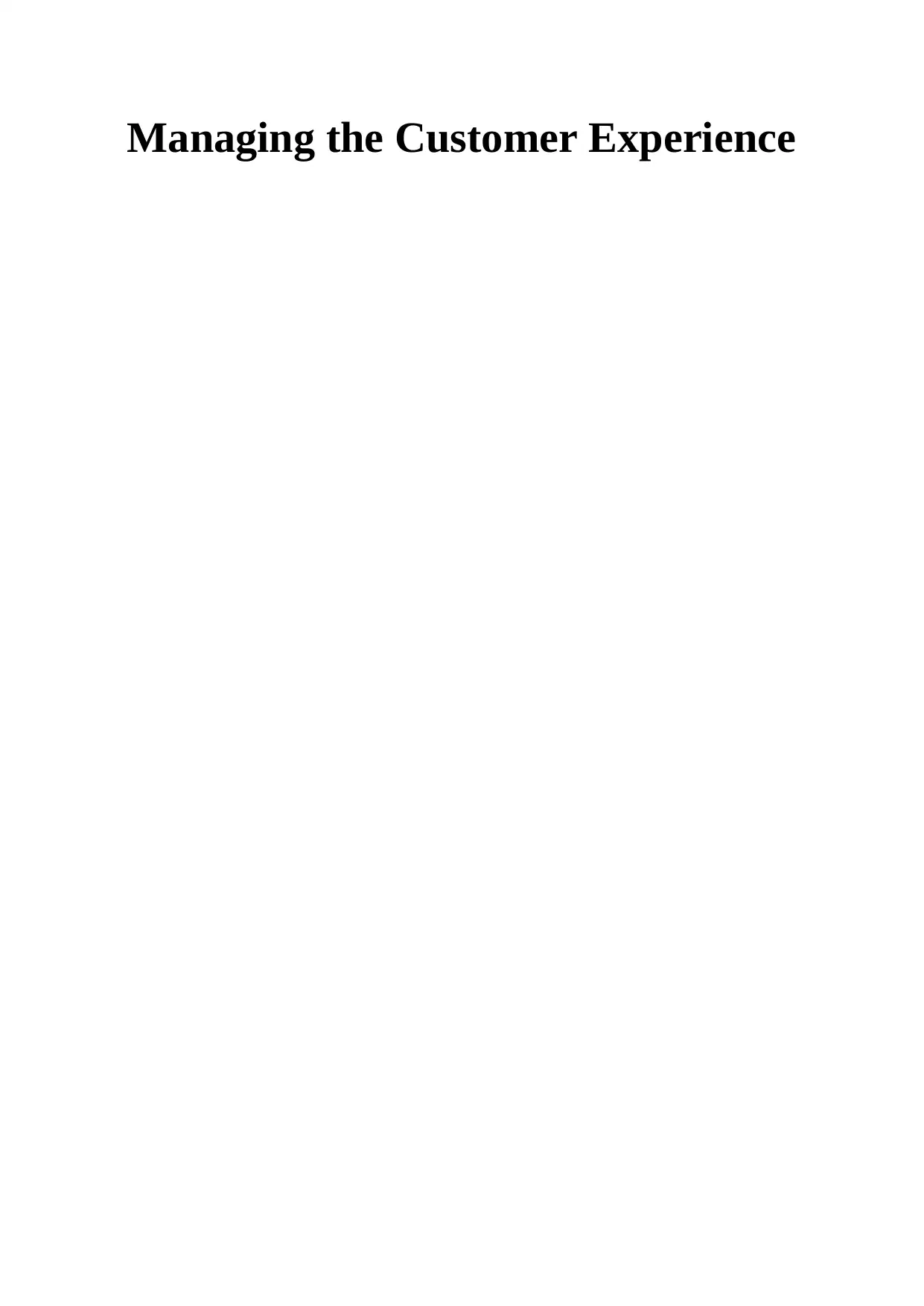
Managing the Customer Experience
Paraphrase This Document
Need a fresh take? Get an instant paraphrase of this document with our AI Paraphraser
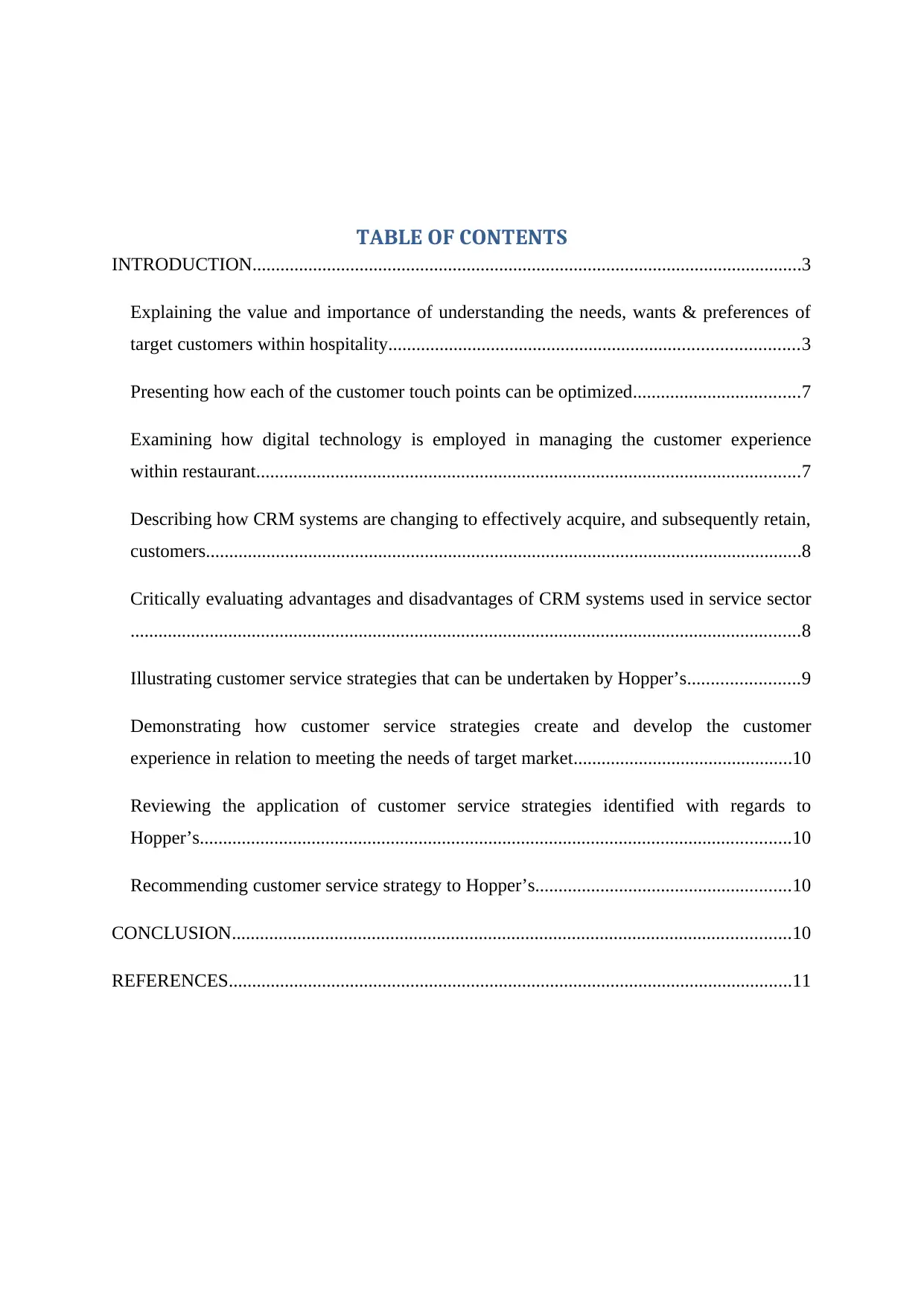
TABLE OF CONTENTS
INTRODUCTION......................................................................................................................3
Explaining the value and importance of understanding the needs, wants & preferences of
target customers within hospitality........................................................................................3
Presenting how each of the customer touch points can be optimized....................................7
Examining how digital technology is employed in managing the customer experience
within restaurant.....................................................................................................................7
Describing how CRM systems are changing to effectively acquire, and subsequently retain,
customers................................................................................................................................8
Critically evaluating advantages and disadvantages of CRM systems used in service sector
................................................................................................................................................8
Illustrating customer service strategies that can be undertaken by Hopper’s........................9
Demonstrating how customer service strategies create and develop the customer
experience in relation to meeting the needs of target market...............................................10
Reviewing the application of customer service strategies identified with regards to
Hopper’s...............................................................................................................................10
Recommending customer service strategy to Hopper’s.......................................................10
CONCLUSION........................................................................................................................10
REFERENCES.........................................................................................................................11
INTRODUCTION......................................................................................................................3
Explaining the value and importance of understanding the needs, wants & preferences of
target customers within hospitality........................................................................................3
Presenting how each of the customer touch points can be optimized....................................7
Examining how digital technology is employed in managing the customer experience
within restaurant.....................................................................................................................7
Describing how CRM systems are changing to effectively acquire, and subsequently retain,
customers................................................................................................................................8
Critically evaluating advantages and disadvantages of CRM systems used in service sector
................................................................................................................................................8
Illustrating customer service strategies that can be undertaken by Hopper’s........................9
Demonstrating how customer service strategies create and develop the customer
experience in relation to meeting the needs of target market...............................................10
Reviewing the application of customer service strategies identified with regards to
Hopper’s...............................................................................................................................10
Recommending customer service strategy to Hopper’s.......................................................10
CONCLUSION........................................................................................................................10
REFERENCES.........................................................................................................................11
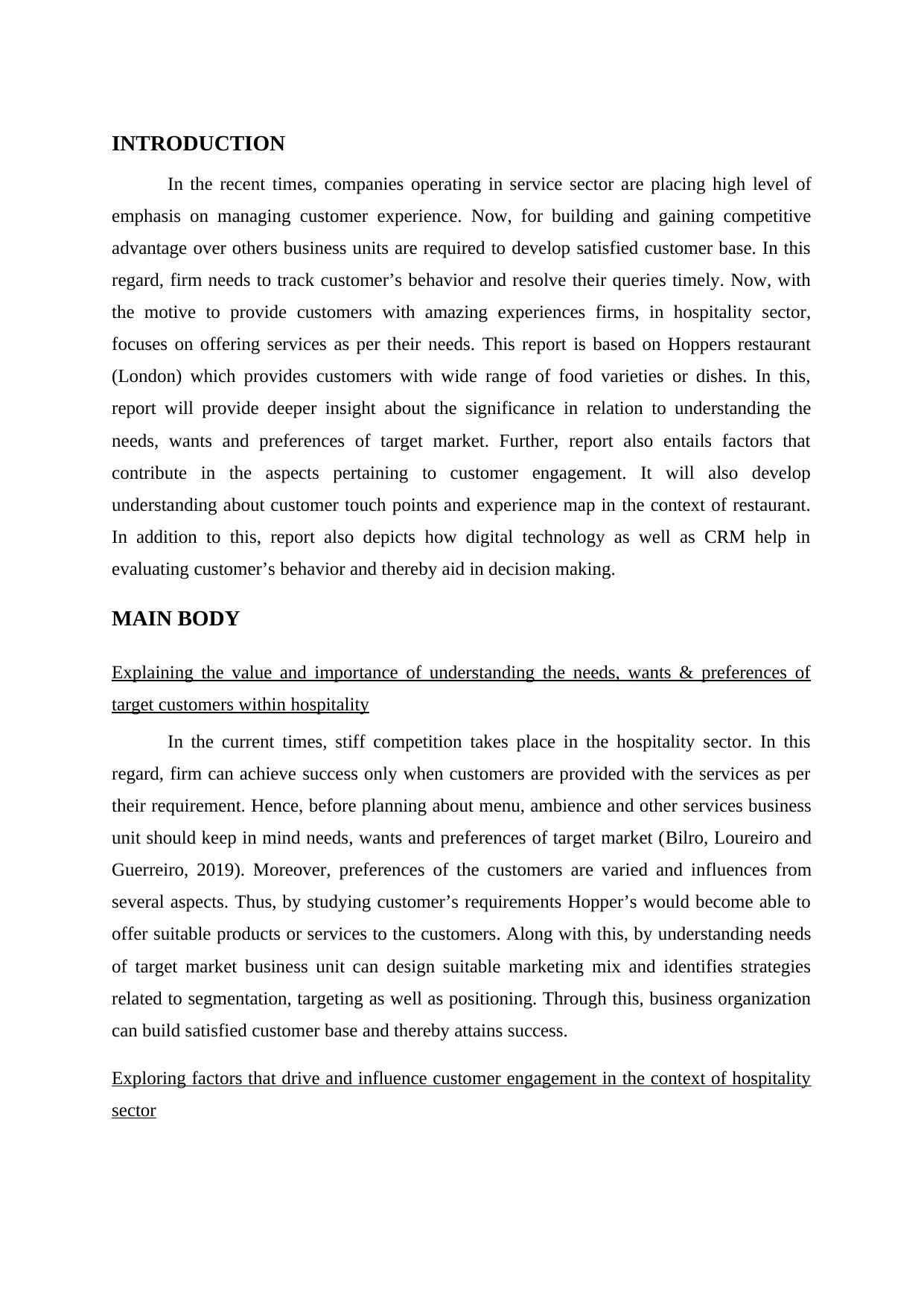
INTRODUCTION
In the recent times, companies operating in service sector are placing high level of
emphasis on managing customer experience. Now, for building and gaining competitive
advantage over others business units are required to develop satisfied customer base. In this
regard, firm needs to track customer’s behavior and resolve their queries timely. Now, with
the motive to provide customers with amazing experiences firms, in hospitality sector,
focuses on offering services as per their needs. This report is based on Hoppers restaurant
(London) which provides customers with wide range of food varieties or dishes. In this,
report will provide deeper insight about the significance in relation to understanding the
needs, wants and preferences of target market. Further, report also entails factors that
contribute in the aspects pertaining to customer engagement. It will also develop
understanding about customer touch points and experience map in the context of restaurant.
In addition to this, report also depicts how digital technology as well as CRM help in
evaluating customer’s behavior and thereby aid in decision making.
MAIN BODY
Explaining the value and importance of understanding the needs, wants & preferences of
target customers within hospitality
In the current times, stiff competition takes place in the hospitality sector. In this
regard, firm can achieve success only when customers are provided with the services as per
their requirement. Hence, before planning about menu, ambience and other services business
unit should keep in mind needs, wants and preferences of target market (Bilro, Loureiro and
Guerreiro, 2019). Moreover, preferences of the customers are varied and influences from
several aspects. Thus, by studying customer’s requirements Hopper’s would become able to
offer suitable products or services to the customers. Along with this, by understanding needs
of target market business unit can design suitable marketing mix and identifies strategies
related to segmentation, targeting as well as positioning. Through this, business organization
can build satisfied customer base and thereby attains success.
Exploring factors that drive and influence customer engagement in the context of hospitality
sector
In the recent times, companies operating in service sector are placing high level of
emphasis on managing customer experience. Now, for building and gaining competitive
advantage over others business units are required to develop satisfied customer base. In this
regard, firm needs to track customer’s behavior and resolve their queries timely. Now, with
the motive to provide customers with amazing experiences firms, in hospitality sector,
focuses on offering services as per their needs. This report is based on Hoppers restaurant
(London) which provides customers with wide range of food varieties or dishes. In this,
report will provide deeper insight about the significance in relation to understanding the
needs, wants and preferences of target market. Further, report also entails factors that
contribute in the aspects pertaining to customer engagement. It will also develop
understanding about customer touch points and experience map in the context of restaurant.
In addition to this, report also depicts how digital technology as well as CRM help in
evaluating customer’s behavior and thereby aid in decision making.
MAIN BODY
Explaining the value and importance of understanding the needs, wants & preferences of
target customers within hospitality
In the current times, stiff competition takes place in the hospitality sector. In this
regard, firm can achieve success only when customers are provided with the services as per
their requirement. Hence, before planning about menu, ambience and other services business
unit should keep in mind needs, wants and preferences of target market (Bilro, Loureiro and
Guerreiro, 2019). Moreover, preferences of the customers are varied and influences from
several aspects. Thus, by studying customer’s requirements Hopper’s would become able to
offer suitable products or services to the customers. Along with this, by understanding needs
of target market business unit can design suitable marketing mix and identifies strategies
related to segmentation, targeting as well as positioning. Through this, business organization
can build satisfied customer base and thereby attains success.
Exploring factors that drive and influence customer engagement in the context of hospitality
sector
⊘ This is a preview!⊘
Do you want full access?
Subscribe today to unlock all pages.

Trusted by 1+ million students worldwide
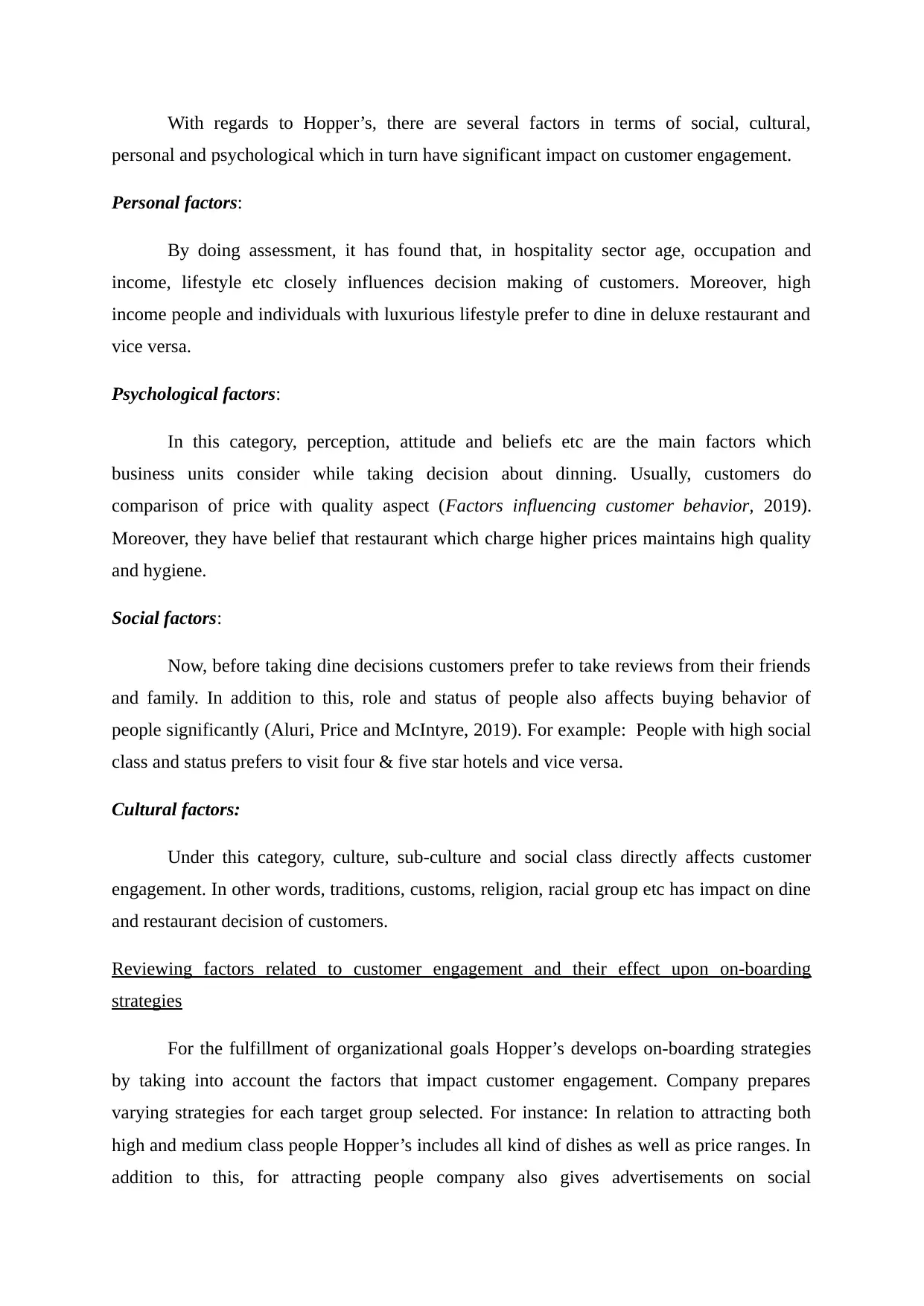
With regards to Hopper’s, there are several factors in terms of social, cultural,
personal and psychological which in turn have significant impact on customer engagement.
Personal factors:
By doing assessment, it has found that, in hospitality sector age, occupation and
income, lifestyle etc closely influences decision making of customers. Moreover, high
income people and individuals with luxurious lifestyle prefer to dine in deluxe restaurant and
vice versa.
Psychological factors:
In this category, perception, attitude and beliefs etc are the main factors which
business units consider while taking decision about dinning. Usually, customers do
comparison of price with quality aspect (Factors influencing customer behavior, 2019).
Moreover, they have belief that restaurant which charge higher prices maintains high quality
and hygiene.
Social factors:
Now, before taking dine decisions customers prefer to take reviews from their friends
and family. In addition to this, role and status of people also affects buying behavior of
people significantly (Aluri, Price and McIntyre, 2019). For example: People with high social
class and status prefers to visit four & five star hotels and vice versa.
Cultural factors:
Under this category, culture, sub-culture and social class directly affects customer
engagement. In other words, traditions, customs, religion, racial group etc has impact on dine
and restaurant decision of customers.
Reviewing factors related to customer engagement and their effect upon on-boarding
strategies
For the fulfillment of organizational goals Hopper’s develops on-boarding strategies
by taking into account the factors that impact customer engagement. Company prepares
varying strategies for each target group selected. For instance: In relation to attracting both
high and medium class people Hopper’s includes all kind of dishes as well as price ranges. In
addition to this, for attracting people company also gives advertisements on social
personal and psychological which in turn have significant impact on customer engagement.
Personal factors:
By doing assessment, it has found that, in hospitality sector age, occupation and
income, lifestyle etc closely influences decision making of customers. Moreover, high
income people and individuals with luxurious lifestyle prefer to dine in deluxe restaurant and
vice versa.
Psychological factors:
In this category, perception, attitude and beliefs etc are the main factors which
business units consider while taking decision about dinning. Usually, customers do
comparison of price with quality aspect (Factors influencing customer behavior, 2019).
Moreover, they have belief that restaurant which charge higher prices maintains high quality
and hygiene.
Social factors:
Now, before taking dine decisions customers prefer to take reviews from their friends
and family. In addition to this, role and status of people also affects buying behavior of
people significantly (Aluri, Price and McIntyre, 2019). For example: People with high social
class and status prefers to visit four & five star hotels and vice versa.
Cultural factors:
Under this category, culture, sub-culture and social class directly affects customer
engagement. In other words, traditions, customs, religion, racial group etc has impact on dine
and restaurant decision of customers.
Reviewing factors related to customer engagement and their effect upon on-boarding
strategies
For the fulfillment of organizational goals Hopper’s develops on-boarding strategies
by taking into account the factors that impact customer engagement. Company prepares
varying strategies for each target group selected. For instance: In relation to attracting both
high and medium class people Hopper’s includes all kind of dishes as well as price ranges. In
addition to this, for attracting people company also gives advertisements on social
Paraphrase This Document
Need a fresh take? Get an instant paraphrase of this document with our AI Paraphraser
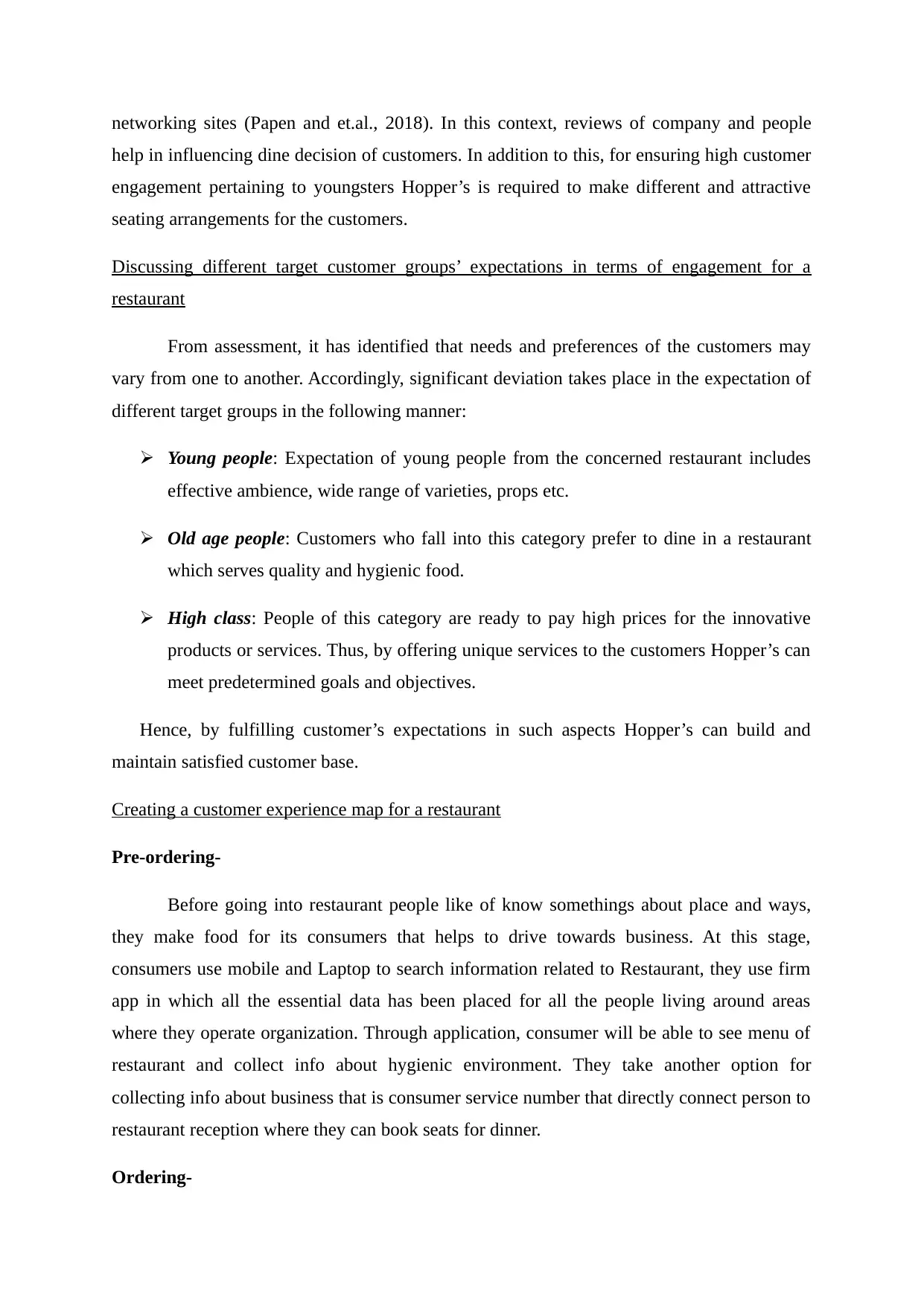
networking sites (Papen and et.al., 2018). In this context, reviews of company and people
help in influencing dine decision of customers. In addition to this, for ensuring high customer
engagement pertaining to youngsters Hopper’s is required to make different and attractive
seating arrangements for the customers.
Discussing different target customer groups’ expectations in terms of engagement for a
restaurant
From assessment, it has identified that needs and preferences of the customers may
vary from one to another. Accordingly, significant deviation takes place in the expectation of
different target groups in the following manner:
Young people: Expectation of young people from the concerned restaurant includes
effective ambience, wide range of varieties, props etc.
Old age people: Customers who fall into this category prefer to dine in a restaurant
which serves quality and hygienic food.
High class: People of this category are ready to pay high prices for the innovative
products or services. Thus, by offering unique services to the customers Hopper’s can
meet predetermined goals and objectives.
Hence, by fulfilling customer’s expectations in such aspects Hopper’s can build and
maintain satisfied customer base.
Creating a customer experience map for a restaurant
Pre-ordering-
Before going into restaurant people like of know somethings about place and ways,
they make food for its consumers that helps to drive towards business. At this stage,
consumers use mobile and Laptop to search information related to Restaurant, they use firm
app in which all the essential data has been placed for all the people living around areas
where they operate organization. Through application, consumer will be able to see menu of
restaurant and collect info about hygienic environment. They take another option for
collecting info about business that is consumer service number that directly connect person to
restaurant reception where they can book seats for dinner.
Ordering-
help in influencing dine decision of customers. In addition to this, for ensuring high customer
engagement pertaining to youngsters Hopper’s is required to make different and attractive
seating arrangements for the customers.
Discussing different target customer groups’ expectations in terms of engagement for a
restaurant
From assessment, it has identified that needs and preferences of the customers may
vary from one to another. Accordingly, significant deviation takes place in the expectation of
different target groups in the following manner:
Young people: Expectation of young people from the concerned restaurant includes
effective ambience, wide range of varieties, props etc.
Old age people: Customers who fall into this category prefer to dine in a restaurant
which serves quality and hygienic food.
High class: People of this category are ready to pay high prices for the innovative
products or services. Thus, by offering unique services to the customers Hopper’s can
meet predetermined goals and objectives.
Hence, by fulfilling customer’s expectations in such aspects Hopper’s can build and
maintain satisfied customer base.
Creating a customer experience map for a restaurant
Pre-ordering-
Before going into restaurant people like of know somethings about place and ways,
they make food for its consumers that helps to drive towards business. At this stage,
consumers use mobile and Laptop to search information related to Restaurant, they use firm
app in which all the essential data has been placed for all the people living around areas
where they operate organization. Through application, consumer will be able to see menu of
restaurant and collect info about hygienic environment. They take another option for
collecting info about business that is consumer service number that directly connect person to
restaurant reception where they can book seats for dinner.
Ordering-
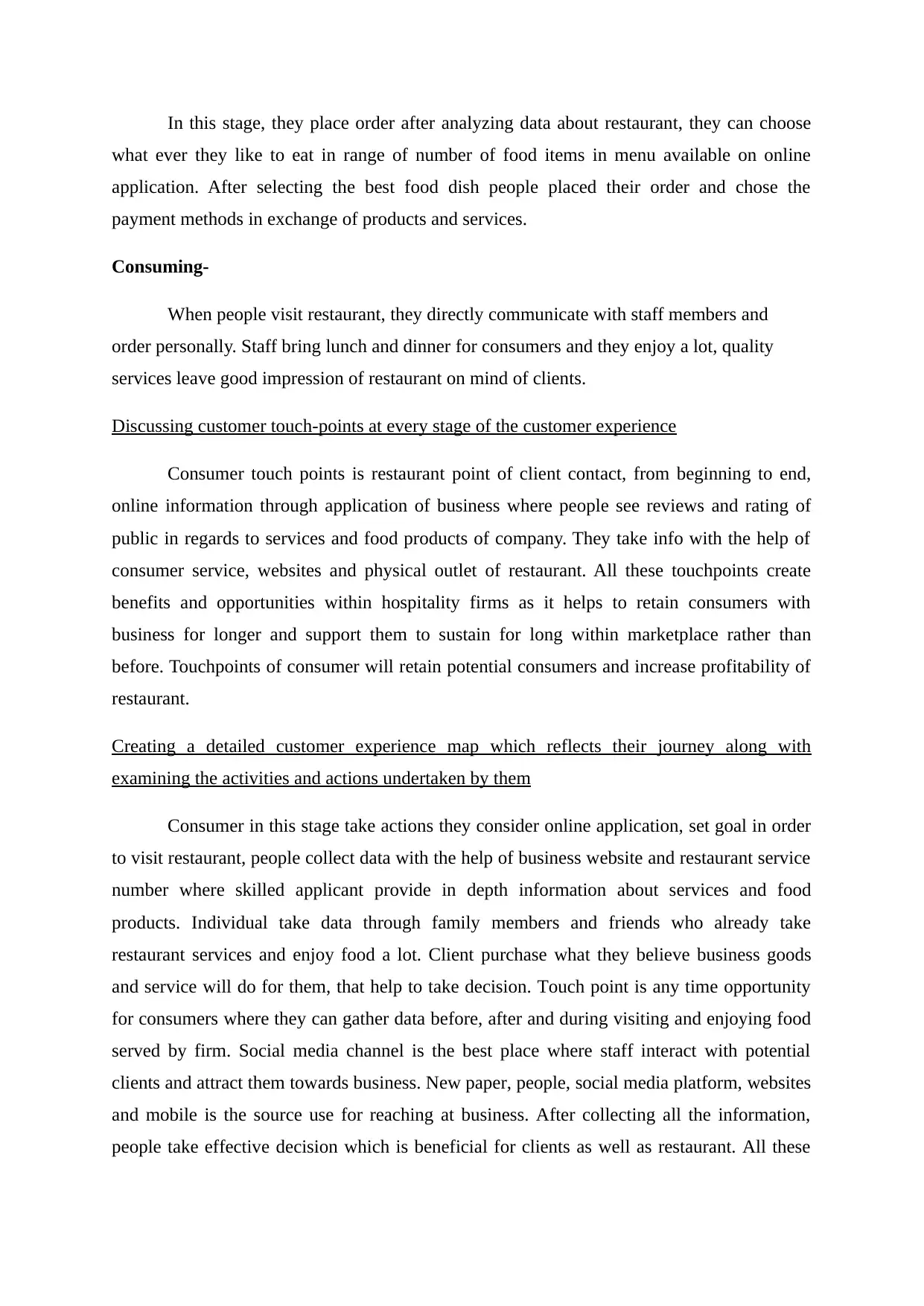
In this stage, they place order after analyzing data about restaurant, they can choose
what ever they like to eat in range of number of food items in menu available on online
application. After selecting the best food dish people placed their order and chose the
payment methods in exchange of products and services.
Consuming-
When people visit restaurant, they directly communicate with staff members and
order personally. Staff bring lunch and dinner for consumers and they enjoy a lot, quality
services leave good impression of restaurant on mind of clients.
Discussing customer touch-points at every stage of the customer experience
Consumer touch points is restaurant point of client contact, from beginning to end,
online information through application of business where people see reviews and rating of
public in regards to services and food products of company. They take info with the help of
consumer service, websites and physical outlet of restaurant. All these touchpoints create
benefits and opportunities within hospitality firms as it helps to retain consumers with
business for longer and support them to sustain for long within marketplace rather than
before. Touchpoints of consumer will retain potential consumers and increase profitability of
restaurant.
Creating a detailed customer experience map which reflects their journey along with
examining the activities and actions undertaken by them
Consumer in this stage take actions they consider online application, set goal in order
to visit restaurant, people collect data with the help of business website and restaurant service
number where skilled applicant provide in depth information about services and food
products. Individual take data through family members and friends who already take
restaurant services and enjoy food a lot. Client purchase what they believe business goods
and service will do for them, that help to take decision. Touch point is any time opportunity
for consumers where they can gather data before, after and during visiting and enjoying food
served by firm. Social media channel is the best place where staff interact with potential
clients and attract them towards business. New paper, people, social media platform, websites
and mobile is the source use for reaching at business. After collecting all the information,
people take effective decision which is beneficial for clients as well as restaurant. All these
what ever they like to eat in range of number of food items in menu available on online
application. After selecting the best food dish people placed their order and chose the
payment methods in exchange of products and services.
Consuming-
When people visit restaurant, they directly communicate with staff members and
order personally. Staff bring lunch and dinner for consumers and they enjoy a lot, quality
services leave good impression of restaurant on mind of clients.
Discussing customer touch-points at every stage of the customer experience
Consumer touch points is restaurant point of client contact, from beginning to end,
online information through application of business where people see reviews and rating of
public in regards to services and food products of company. They take info with the help of
consumer service, websites and physical outlet of restaurant. All these touchpoints create
benefits and opportunities within hospitality firms as it helps to retain consumers with
business for longer and support them to sustain for long within marketplace rather than
before. Touchpoints of consumer will retain potential consumers and increase profitability of
restaurant.
Creating a detailed customer experience map which reflects their journey along with
examining the activities and actions undertaken by them
Consumer in this stage take actions they consider online application, set goal in order
to visit restaurant, people collect data with the help of business website and restaurant service
number where skilled applicant provide in depth information about services and food
products. Individual take data through family members and friends who already take
restaurant services and enjoy food a lot. Client purchase what they believe business goods
and service will do for them, that help to take decision. Touch point is any time opportunity
for consumers where they can gather data before, after and during visiting and enjoying food
served by firm. Social media channel is the best place where staff interact with potential
clients and attract them towards business. New paper, people, social media platform, websites
and mobile is the source use for reaching at business. After collecting all the information,
people take effective decision which is beneficial for clients as well as restaurant. All these
⊘ This is a preview!⊘
Do you want full access?
Subscribe today to unlock all pages.

Trusted by 1+ million students worldwide
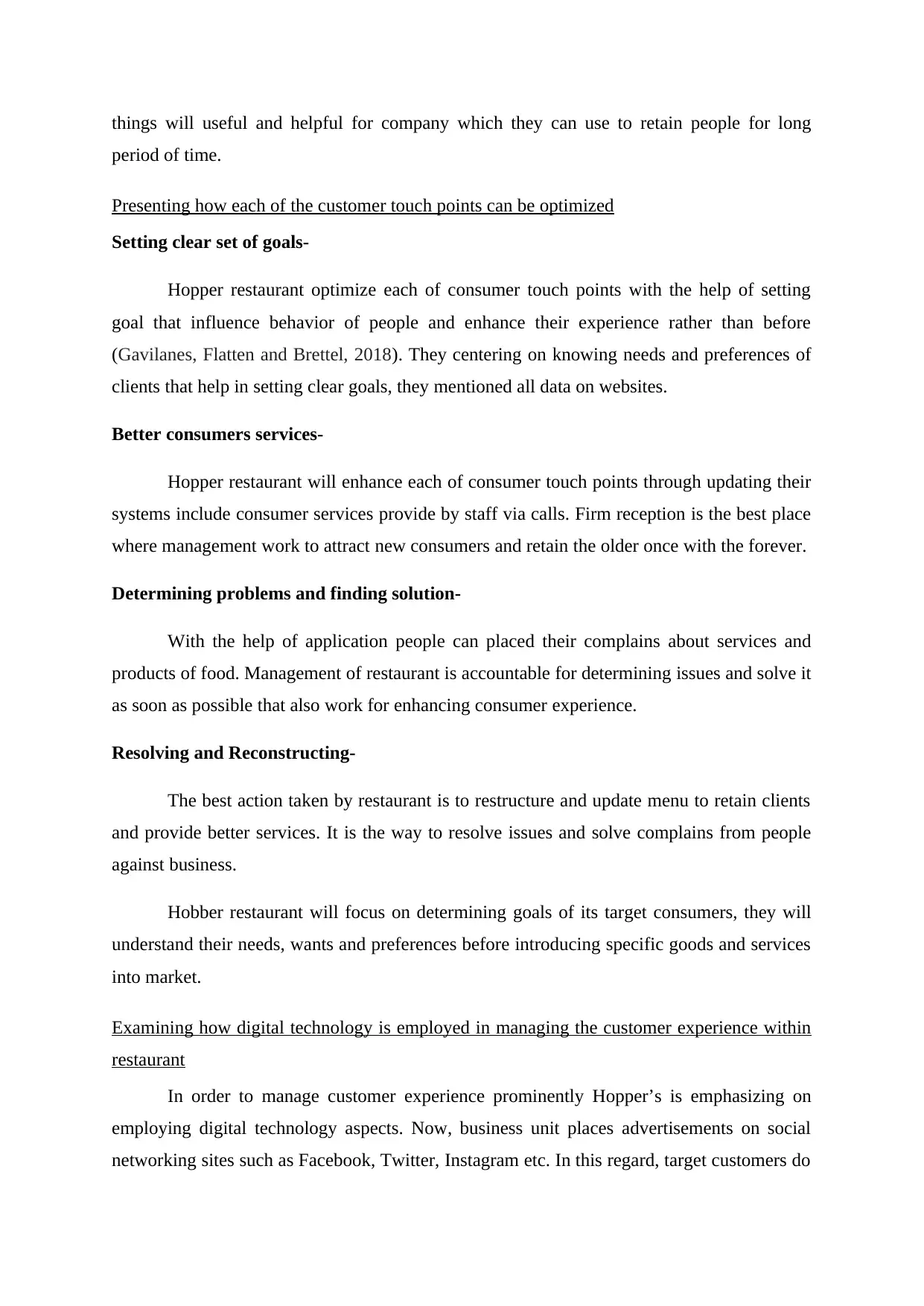
things will useful and helpful for company which they can use to retain people for long
period of time.
Presenting how each of the customer touch points can be optimized
Setting clear set of goals-
Hopper restaurant optimize each of consumer touch points with the help of setting
goal that influence behavior of people and enhance their experience rather than before
(Gavilanes, Flatten and Brettel, 2018). They centering on knowing needs and preferences of
clients that help in setting clear goals, they mentioned all data on websites.
Better consumers services-
Hopper restaurant will enhance each of consumer touch points through updating their
systems include consumer services provide by staff via calls. Firm reception is the best place
where management work to attract new consumers and retain the older once with the forever.
Determining problems and finding solution-
With the help of application people can placed their complains about services and
products of food. Management of restaurant is accountable for determining issues and solve it
as soon as possible that also work for enhancing consumer experience.
Resolving and Reconstructing-
The best action taken by restaurant is to restructure and update menu to retain clients
and provide better services. It is the way to resolve issues and solve complains from people
against business.
Hobber restaurant will focus on determining goals of its target consumers, they will
understand their needs, wants and preferences before introducing specific goods and services
into market.
Examining how digital technology is employed in managing the customer experience within
restaurant
In order to manage customer experience prominently Hopper’s is emphasizing on
employing digital technology aspects. Now, business unit places advertisements on social
networking sites such as Facebook, Twitter, Instagram etc. In this regard, target customers do
period of time.
Presenting how each of the customer touch points can be optimized
Setting clear set of goals-
Hopper restaurant optimize each of consumer touch points with the help of setting
goal that influence behavior of people and enhance their experience rather than before
(Gavilanes, Flatten and Brettel, 2018). They centering on knowing needs and preferences of
clients that help in setting clear goals, they mentioned all data on websites.
Better consumers services-
Hopper restaurant will enhance each of consumer touch points through updating their
systems include consumer services provide by staff via calls. Firm reception is the best place
where management work to attract new consumers and retain the older once with the forever.
Determining problems and finding solution-
With the help of application people can placed their complains about services and
products of food. Management of restaurant is accountable for determining issues and solve it
as soon as possible that also work for enhancing consumer experience.
Resolving and Reconstructing-
The best action taken by restaurant is to restructure and update menu to retain clients
and provide better services. It is the way to resolve issues and solve complains from people
against business.
Hobber restaurant will focus on determining goals of its target consumers, they will
understand their needs, wants and preferences before introducing specific goods and services
into market.
Examining how digital technology is employed in managing the customer experience within
restaurant
In order to manage customer experience prominently Hopper’s is emphasizing on
employing digital technology aspects. Now, business unit places advertisements on social
networking sites such as Facebook, Twitter, Instagram etc. In this regard, target customers do
Paraphrase This Document
Need a fresh take? Get an instant paraphrase of this document with our AI Paraphraser
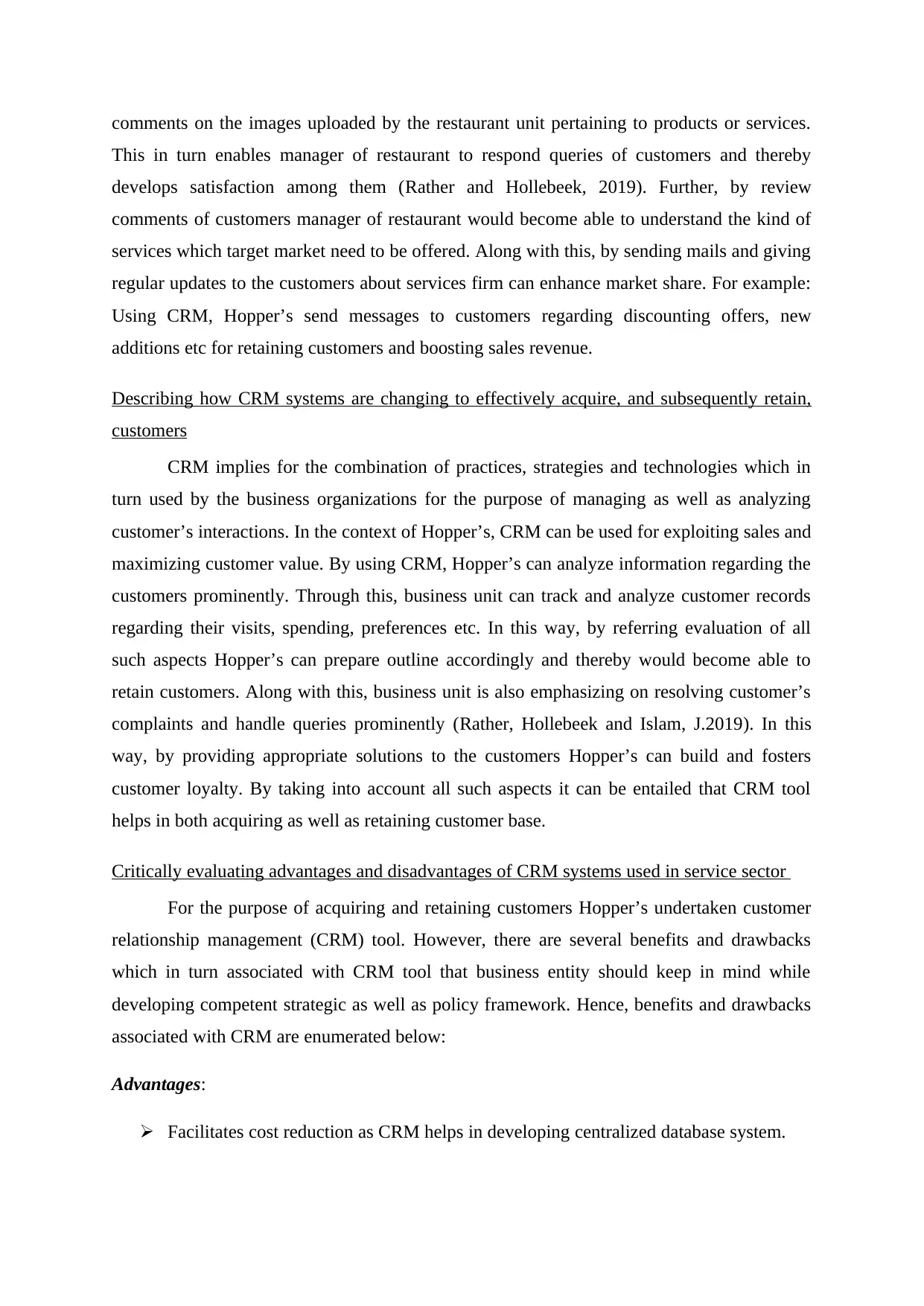
comments on the images uploaded by the restaurant unit pertaining to products or services.
This in turn enables manager of restaurant to respond queries of customers and thereby
develops satisfaction among them (Rather and Hollebeek, 2019). Further, by review
comments of customers manager of restaurant would become able to understand the kind of
services which target market need to be offered. Along with this, by sending mails and giving
regular updates to the customers about services firm can enhance market share. For example:
Using CRM, Hopper’s send messages to customers regarding discounting offers, new
additions etc for retaining customers and boosting sales revenue.
Describing how CRM systems are changing to effectively acquire, and subsequently retain,
customers
CRM implies for the combination of practices, strategies and technologies which in
turn used by the business organizations for the purpose of managing as well as analyzing
customer’s interactions. In the context of Hopper’s, CRM can be used for exploiting sales and
maximizing customer value. By using CRM, Hopper’s can analyze information regarding the
customers prominently. Through this, business unit can track and analyze customer records
regarding their visits, spending, preferences etc. In this way, by referring evaluation of all
such aspects Hopper’s can prepare outline accordingly and thereby would become able to
retain customers. Along with this, business unit is also emphasizing on resolving customer’s
complaints and handle queries prominently (Rather, Hollebeek and Islam, J.2019). In this
way, by providing appropriate solutions to the customers Hopper’s can build and fosters
customer loyalty. By taking into account all such aspects it can be entailed that CRM tool
helps in both acquiring as well as retaining customer base.
Critically evaluating advantages and disadvantages of CRM systems used in service sector
For the purpose of acquiring and retaining customers Hopper’s undertaken customer
relationship management (CRM) tool. However, there are several benefits and drawbacks
which in turn associated with CRM tool that business entity should keep in mind while
developing competent strategic as well as policy framework. Hence, benefits and drawbacks
associated with CRM are enumerated below:
Advantages:
Facilitates cost reduction as CRM helps in developing centralized database system.
This in turn enables manager of restaurant to respond queries of customers and thereby
develops satisfaction among them (Rather and Hollebeek, 2019). Further, by review
comments of customers manager of restaurant would become able to understand the kind of
services which target market need to be offered. Along with this, by sending mails and giving
regular updates to the customers about services firm can enhance market share. For example:
Using CRM, Hopper’s send messages to customers regarding discounting offers, new
additions etc for retaining customers and boosting sales revenue.
Describing how CRM systems are changing to effectively acquire, and subsequently retain,
customers
CRM implies for the combination of practices, strategies and technologies which in
turn used by the business organizations for the purpose of managing as well as analyzing
customer’s interactions. In the context of Hopper’s, CRM can be used for exploiting sales and
maximizing customer value. By using CRM, Hopper’s can analyze information regarding the
customers prominently. Through this, business unit can track and analyze customer records
regarding their visits, spending, preferences etc. In this way, by referring evaluation of all
such aspects Hopper’s can prepare outline accordingly and thereby would become able to
retain customers. Along with this, business unit is also emphasizing on resolving customer’s
complaints and handle queries prominently (Rather, Hollebeek and Islam, J.2019). In this
way, by providing appropriate solutions to the customers Hopper’s can build and fosters
customer loyalty. By taking into account all such aspects it can be entailed that CRM tool
helps in both acquiring as well as retaining customer base.
Critically evaluating advantages and disadvantages of CRM systems used in service sector
For the purpose of acquiring and retaining customers Hopper’s undertaken customer
relationship management (CRM) tool. However, there are several benefits and drawbacks
which in turn associated with CRM tool that business entity should keep in mind while
developing competent strategic as well as policy framework. Hence, benefits and drawbacks
associated with CRM are enumerated below:
Advantages:
Facilitates cost reduction as CRM helps in developing centralized database system.
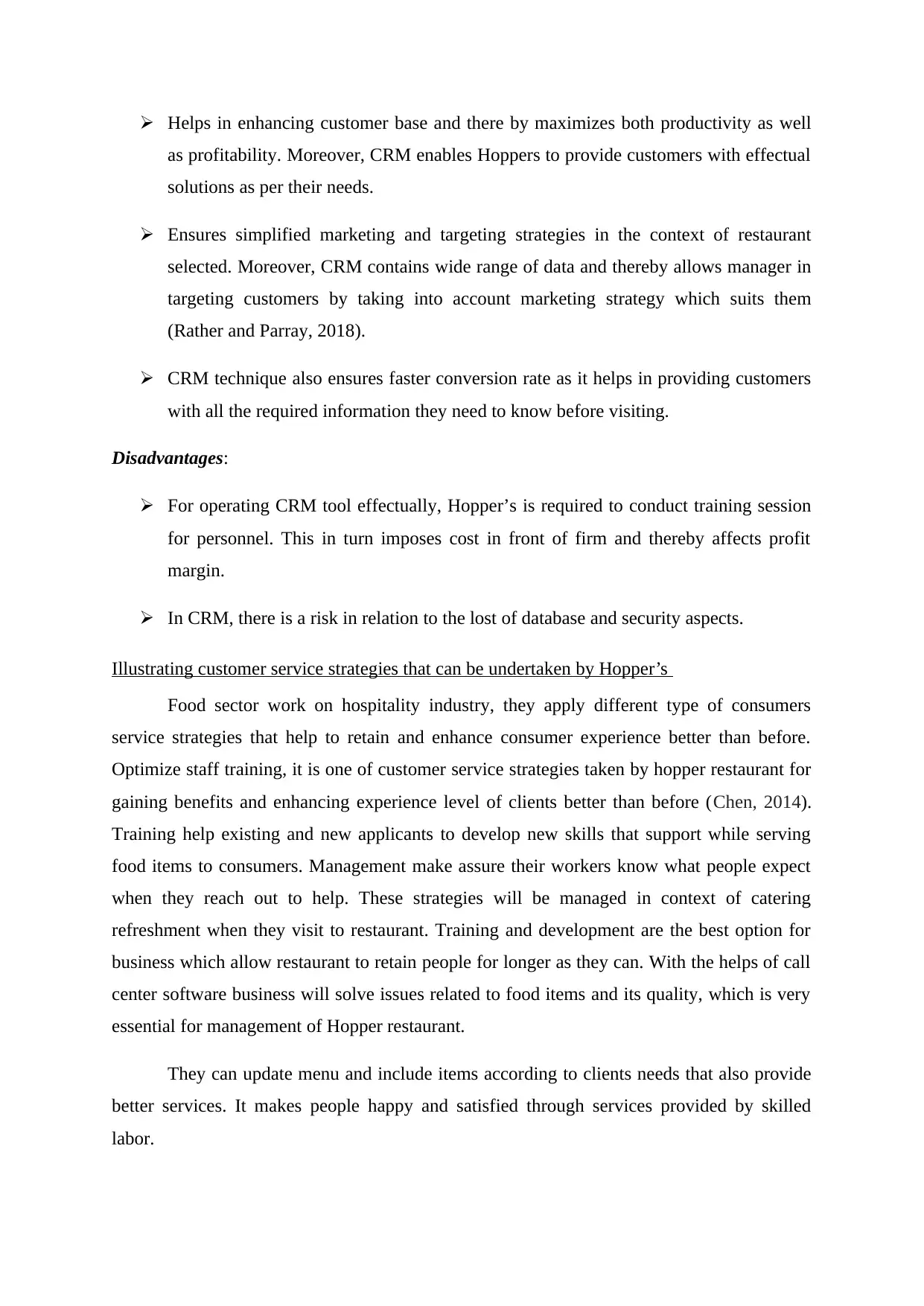
Helps in enhancing customer base and there by maximizes both productivity as well
as profitability. Moreover, CRM enables Hoppers to provide customers with effectual
solutions as per their needs.
Ensures simplified marketing and targeting strategies in the context of restaurant
selected. Moreover, CRM contains wide range of data and thereby allows manager in
targeting customers by taking into account marketing strategy which suits them
(Rather and Parray, 2018).
CRM technique also ensures faster conversion rate as it helps in providing customers
with all the required information they need to know before visiting.
Disadvantages:
For operating CRM tool effectually, Hopper’s is required to conduct training session
for personnel. This in turn imposes cost in front of firm and thereby affects profit
margin.
In CRM, there is a risk in relation to the lost of database and security aspects.
Illustrating customer service strategies that can be undertaken by Hopper’s
Food sector work on hospitality industry, they apply different type of consumers
service strategies that help to retain and enhance consumer experience better than before.
Optimize staff training, it is one of customer service strategies taken by hopper restaurant for
gaining benefits and enhancing experience level of clients better than before (Chen, 2014).
Training help existing and new applicants to develop new skills that support while serving
food items to consumers. Management make assure their workers know what people expect
when they reach out to help. These strategies will be managed in context of catering
refreshment when they visit to restaurant. Training and development are the best option for
business which allow restaurant to retain people for longer as they can. With the helps of call
center software business will solve issues related to food items and its quality, which is very
essential for management of Hopper restaurant.
They can update menu and include items according to clients needs that also provide
better services. It makes people happy and satisfied through services provided by skilled
labor.
as profitability. Moreover, CRM enables Hoppers to provide customers with effectual
solutions as per their needs.
Ensures simplified marketing and targeting strategies in the context of restaurant
selected. Moreover, CRM contains wide range of data and thereby allows manager in
targeting customers by taking into account marketing strategy which suits them
(Rather and Parray, 2018).
CRM technique also ensures faster conversion rate as it helps in providing customers
with all the required information they need to know before visiting.
Disadvantages:
For operating CRM tool effectually, Hopper’s is required to conduct training session
for personnel. This in turn imposes cost in front of firm and thereby affects profit
margin.
In CRM, there is a risk in relation to the lost of database and security aspects.
Illustrating customer service strategies that can be undertaken by Hopper’s
Food sector work on hospitality industry, they apply different type of consumers
service strategies that help to retain and enhance consumer experience better than before.
Optimize staff training, it is one of customer service strategies taken by hopper restaurant for
gaining benefits and enhancing experience level of clients better than before (Chen, 2014).
Training help existing and new applicants to develop new skills that support while serving
food items to consumers. Management make assure their workers know what people expect
when they reach out to help. These strategies will be managed in context of catering
refreshment when they visit to restaurant. Training and development are the best option for
business which allow restaurant to retain people for longer as they can. With the helps of call
center software business will solve issues related to food items and its quality, which is very
essential for management of Hopper restaurant.
They can update menu and include items according to clients needs that also provide
better services. It makes people happy and satisfied through services provided by skilled
labor.
⊘ This is a preview!⊘
Do you want full access?
Subscribe today to unlock all pages.

Trusted by 1+ million students worldwide
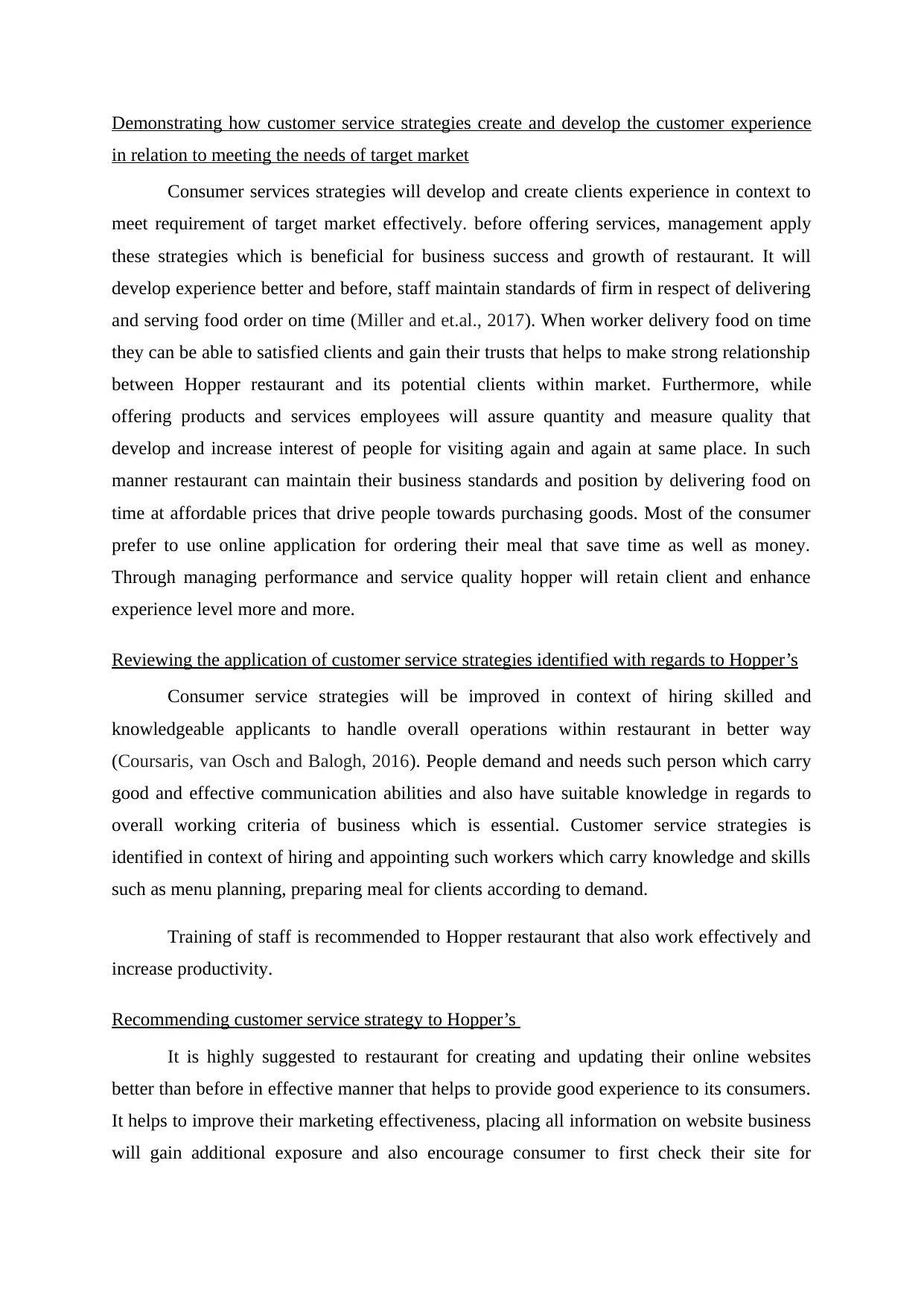
Demonstrating how customer service strategies create and develop the customer experience
in relation to meeting the needs of target market
Consumer services strategies will develop and create clients experience in context to
meet requirement of target market effectively. before offering services, management apply
these strategies which is beneficial for business success and growth of restaurant. It will
develop experience better and before, staff maintain standards of firm in respect of delivering
and serving food order on time (Miller and et.al., 2017). When worker delivery food on time
they can be able to satisfied clients and gain their trusts that helps to make strong relationship
between Hopper restaurant and its potential clients within market. Furthermore, while
offering products and services employees will assure quantity and measure quality that
develop and increase interest of people for visiting again and again at same place. In such
manner restaurant can maintain their business standards and position by delivering food on
time at affordable prices that drive people towards purchasing goods. Most of the consumer
prefer to use online application for ordering their meal that save time as well as money.
Through managing performance and service quality hopper will retain client and enhance
experience level more and more.
Reviewing the application of customer service strategies identified with regards to Hopper’s
Consumer service strategies will be improved in context of hiring skilled and
knowledgeable applicants to handle overall operations within restaurant in better way
(Coursaris, van Osch and Balogh, 2016). People demand and needs such person which carry
good and effective communication abilities and also have suitable knowledge in regards to
overall working criteria of business which is essential. Customer service strategies is
identified in context of hiring and appointing such workers which carry knowledge and skills
such as menu planning, preparing meal for clients according to demand.
Training of staff is recommended to Hopper restaurant that also work effectively and
increase productivity.
Recommending customer service strategy to Hopper’s
It is highly suggested to restaurant for creating and updating their online websites
better than before in effective manner that helps to provide good experience to its consumers.
It helps to improve their marketing effectiveness, placing all information on website business
will gain additional exposure and also encourage consumer to first check their site for
in relation to meeting the needs of target market
Consumer services strategies will develop and create clients experience in context to
meet requirement of target market effectively. before offering services, management apply
these strategies which is beneficial for business success and growth of restaurant. It will
develop experience better and before, staff maintain standards of firm in respect of delivering
and serving food order on time (Miller and et.al., 2017). When worker delivery food on time
they can be able to satisfied clients and gain their trusts that helps to make strong relationship
between Hopper restaurant and its potential clients within market. Furthermore, while
offering products and services employees will assure quantity and measure quality that
develop and increase interest of people for visiting again and again at same place. In such
manner restaurant can maintain their business standards and position by delivering food on
time at affordable prices that drive people towards purchasing goods. Most of the consumer
prefer to use online application for ordering their meal that save time as well as money.
Through managing performance and service quality hopper will retain client and enhance
experience level more and more.
Reviewing the application of customer service strategies identified with regards to Hopper’s
Consumer service strategies will be improved in context of hiring skilled and
knowledgeable applicants to handle overall operations within restaurant in better way
(Coursaris, van Osch and Balogh, 2016). People demand and needs such person which carry
good and effective communication abilities and also have suitable knowledge in regards to
overall working criteria of business which is essential. Customer service strategies is
identified in context of hiring and appointing such workers which carry knowledge and skills
such as menu planning, preparing meal for clients according to demand.
Training of staff is recommended to Hopper restaurant that also work effectively and
increase productivity.
Recommending customer service strategy to Hopper’s
It is highly suggested to restaurant for creating and updating their online websites
better than before in effective manner that helps to provide good experience to its consumers.
It helps to improve their marketing effectiveness, placing all information on website business
will gain additional exposure and also encourage consumer to first check their site for
Paraphrase This Document
Need a fresh take? Get an instant paraphrase of this document with our AI Paraphraser
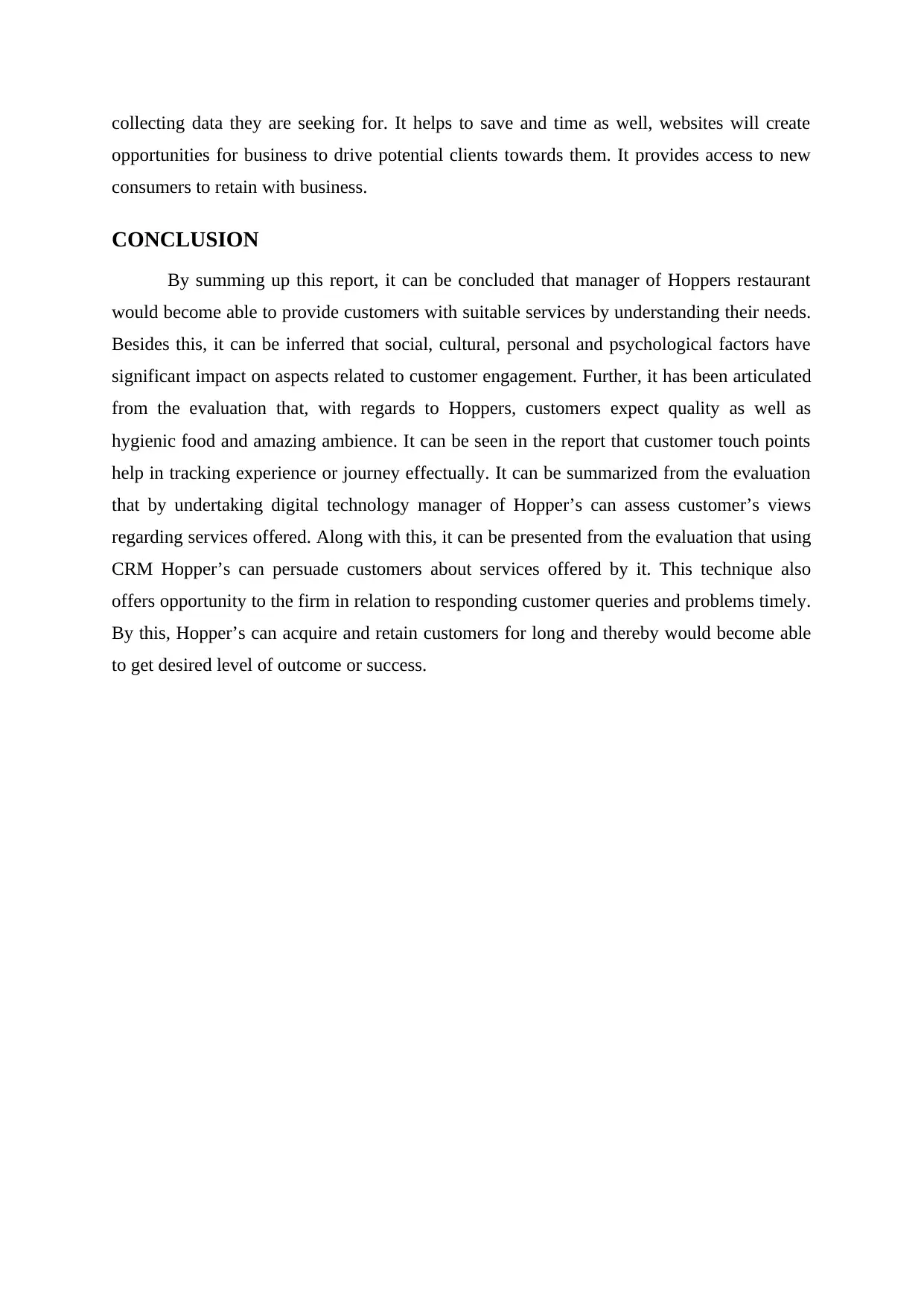
collecting data they are seeking for. It helps to save and time as well, websites will create
opportunities for business to drive potential clients towards them. It provides access to new
consumers to retain with business.
CONCLUSION
By summing up this report, it can be concluded that manager of Hoppers restaurant
would become able to provide customers with suitable services by understanding their needs.
Besides this, it can be inferred that social, cultural, personal and psychological factors have
significant impact on aspects related to customer engagement. Further, it has been articulated
from the evaluation that, with regards to Hoppers, customers expect quality as well as
hygienic food and amazing ambience. It can be seen in the report that customer touch points
help in tracking experience or journey effectually. It can be summarized from the evaluation
that by undertaking digital technology manager of Hopper’s can assess customer’s views
regarding services offered. Along with this, it can be presented from the evaluation that using
CRM Hopper’s can persuade customers about services offered by it. This technique also
offers opportunity to the firm in relation to responding customer queries and problems timely.
By this, Hopper’s can acquire and retain customers for long and thereby would become able
to get desired level of outcome or success.
opportunities for business to drive potential clients towards them. It provides access to new
consumers to retain with business.
CONCLUSION
By summing up this report, it can be concluded that manager of Hoppers restaurant
would become able to provide customers with suitable services by understanding their needs.
Besides this, it can be inferred that social, cultural, personal and psychological factors have
significant impact on aspects related to customer engagement. Further, it has been articulated
from the evaluation that, with regards to Hoppers, customers expect quality as well as
hygienic food and amazing ambience. It can be seen in the report that customer touch points
help in tracking experience or journey effectually. It can be summarized from the evaluation
that by undertaking digital technology manager of Hopper’s can assess customer’s views
regarding services offered. Along with this, it can be presented from the evaluation that using
CRM Hopper’s can persuade customers about services offered by it. This technique also
offers opportunity to the firm in relation to responding customer queries and problems timely.
By this, Hopper’s can acquire and retain customers for long and thereby would become able
to get desired level of outcome or success.
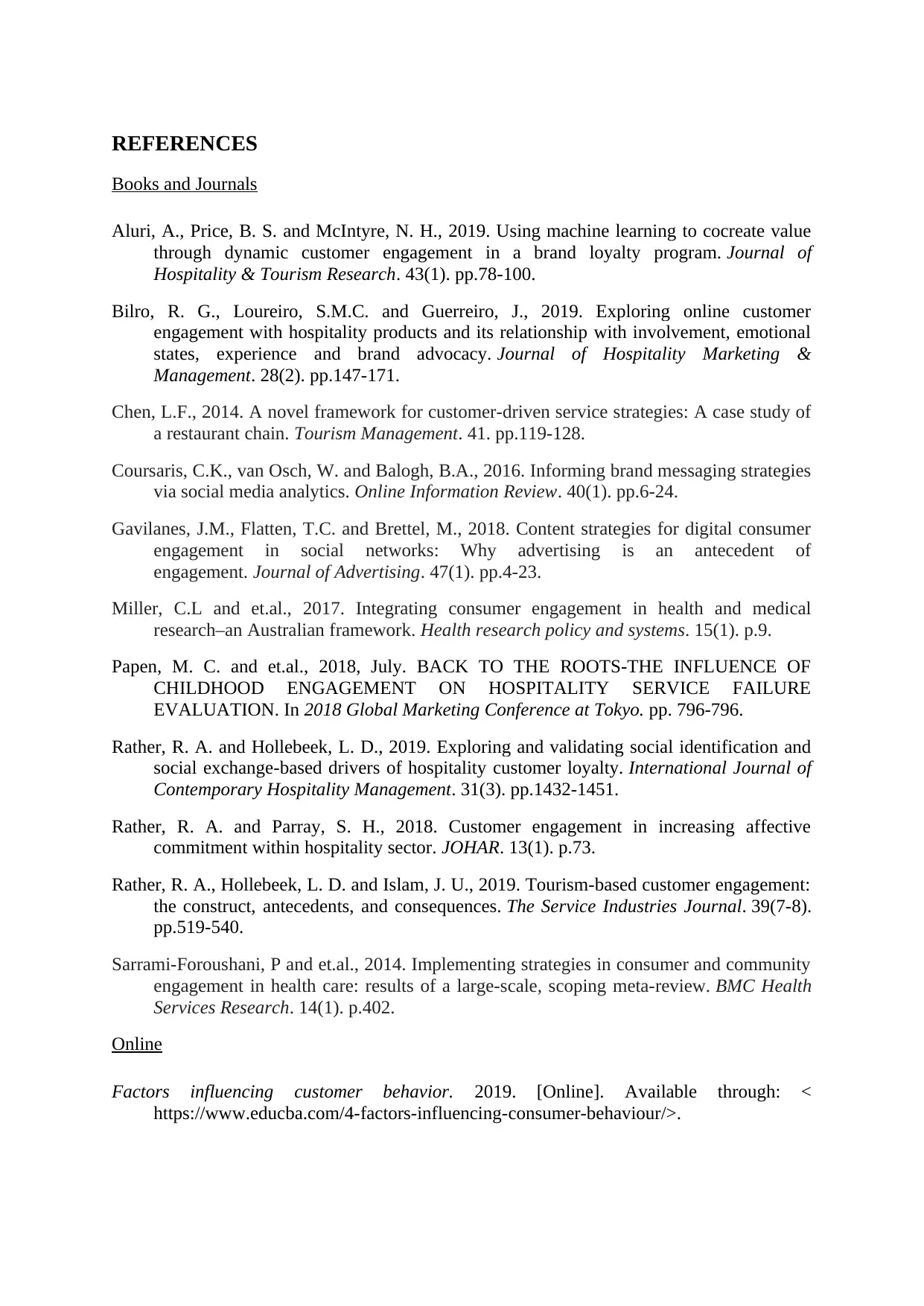
REFERENCES
Books and Journals
Aluri, A., Price, B. S. and McIntyre, N. H., 2019. Using machine learning to cocreate value
through dynamic customer engagement in a brand loyalty program. Journal of
Hospitality & Tourism Research. 43(1). pp.78-100.
Bilro, R. G., Loureiro, S.M.C. and Guerreiro, J., 2019. Exploring online customer
engagement with hospitality products and its relationship with involvement, emotional
states, experience and brand advocacy. Journal of Hospitality Marketing &
Management. 28(2). pp.147-171.
Chen, L.F., 2014. A novel framework for customer-driven service strategies: A case study of
a restaurant chain. Tourism Management. 41. pp.119-128.
Coursaris, C.K., van Osch, W. and Balogh, B.A., 2016. Informing brand messaging strategies
via social media analytics. Online Information Review. 40(1). pp.6-24.
Gavilanes, J.M., Flatten, T.C. and Brettel, M., 2018. Content strategies for digital consumer
engagement in social networks: Why advertising is an antecedent of
engagement. Journal of Advertising. 47(1). pp.4-23.
Miller, C.L and et.al., 2017. Integrating consumer engagement in health and medical
research–an Australian framework. Health research policy and systems. 15(1). p.9.
Papen, M. C. and et.al., 2018, July. BACK TO THE ROOTS-THE INFLUENCE OF
CHILDHOOD ENGAGEMENT ON HOSPITALITY SERVICE FAILURE
EVALUATION. In 2018 Global Marketing Conference at Tokyo. pp. 796-796.
Rather, R. A. and Hollebeek, L. D., 2019. Exploring and validating social identification and
social exchange-based drivers of hospitality customer loyalty. International Journal of
Contemporary Hospitality Management. 31(3). pp.1432-1451.
Rather, R. A. and Parray, S. H., 2018. Customer engagement in increasing affective
commitment within hospitality sector. JOHAR. 13(1). p.73.
Rather, R. A., Hollebeek, L. D. and Islam, J. U., 2019. Tourism-based customer engagement:
the construct, antecedents, and consequences. The Service Industries Journal. 39(7-8).
pp.519-540.
Sarrami-Foroushani, P and et.al., 2014. Implementing strategies in consumer and community
engagement in health care: results of a large-scale, scoping meta-review. BMC Health
Services Research. 14(1). p.402.
Online
Factors influencing customer behavior. 2019. [Online]. Available through: <
https://www.educba.com/4-factors-influencing-consumer-behaviour/>.
Books and Journals
Aluri, A., Price, B. S. and McIntyre, N. H., 2019. Using machine learning to cocreate value
through dynamic customer engagement in a brand loyalty program. Journal of
Hospitality & Tourism Research. 43(1). pp.78-100.
Bilro, R. G., Loureiro, S.M.C. and Guerreiro, J., 2019. Exploring online customer
engagement with hospitality products and its relationship with involvement, emotional
states, experience and brand advocacy. Journal of Hospitality Marketing &
Management. 28(2). pp.147-171.
Chen, L.F., 2014. A novel framework for customer-driven service strategies: A case study of
a restaurant chain. Tourism Management. 41. pp.119-128.
Coursaris, C.K., van Osch, W. and Balogh, B.A., 2016. Informing brand messaging strategies
via social media analytics. Online Information Review. 40(1). pp.6-24.
Gavilanes, J.M., Flatten, T.C. and Brettel, M., 2018. Content strategies for digital consumer
engagement in social networks: Why advertising is an antecedent of
engagement. Journal of Advertising. 47(1). pp.4-23.
Miller, C.L and et.al., 2017. Integrating consumer engagement in health and medical
research–an Australian framework. Health research policy and systems. 15(1). p.9.
Papen, M. C. and et.al., 2018, July. BACK TO THE ROOTS-THE INFLUENCE OF
CHILDHOOD ENGAGEMENT ON HOSPITALITY SERVICE FAILURE
EVALUATION. In 2018 Global Marketing Conference at Tokyo. pp. 796-796.
Rather, R. A. and Hollebeek, L. D., 2019. Exploring and validating social identification and
social exchange-based drivers of hospitality customer loyalty. International Journal of
Contemporary Hospitality Management. 31(3). pp.1432-1451.
Rather, R. A. and Parray, S. H., 2018. Customer engagement in increasing affective
commitment within hospitality sector. JOHAR. 13(1). p.73.
Rather, R. A., Hollebeek, L. D. and Islam, J. U., 2019. Tourism-based customer engagement:
the construct, antecedents, and consequences. The Service Industries Journal. 39(7-8).
pp.519-540.
Sarrami-Foroushani, P and et.al., 2014. Implementing strategies in consumer and community
engagement in health care: results of a large-scale, scoping meta-review. BMC Health
Services Research. 14(1). p.402.
Online
Factors influencing customer behavior. 2019. [Online]. Available through: <
https://www.educba.com/4-factors-influencing-consumer-behaviour/>.
⊘ This is a preview!⊘
Do you want full access?
Subscribe today to unlock all pages.

Trusted by 1+ million students worldwide
1 out of 13
Related Documents
Your All-in-One AI-Powered Toolkit for Academic Success.
+13062052269
info@desklib.com
Available 24*7 on WhatsApp / Email
![[object Object]](/_next/static/media/star-bottom.7253800d.svg)
Unlock your academic potential
Copyright © 2020–2025 A2Z Services. All Rights Reserved. Developed and managed by ZUCOL.




